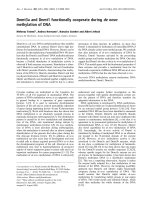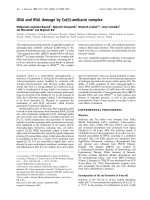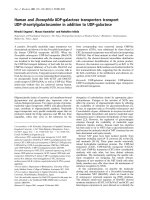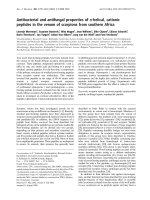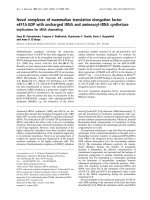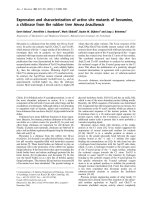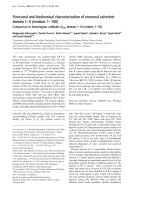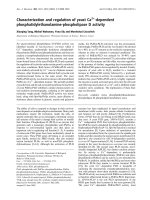Báo cáo y học: "Morning and evening behavior in children and adolescents treated with atomoxetine once daily for Attention-Deficit/Hyperactivity Disorder (ADHD): Findings from two 24-week, open-label studie" potx
Bạn đang xem bản rút gọn của tài liệu. Xem và tải ngay bản đầy đủ của tài liệu tại đây (885.2 KB, 10 trang )
BioMed Central
Page 1 of 10
(page number not for citation purposes)
Child and Adolescent Psychiatry and
Mental Health
Open Access
Research
Morning and evening behavior in children and adolescents treated
with atomoxetine once daily for Attention-Deficit/Hyperactivity
Disorder (ADHD): Findings from two 24-week, open-label studies
Peter M Wehmeier*
1
, Ralf W Dittmann
2
, Alexander Schacht
1
, Karin Helsberg
1
and Gerd Lehmkuhl
3
Address:
1
Lilly Deutschland, Medical Department, Bad Homburg, Germany,
2
Department of Child and Adolescent Psychiatry, Central Institute of
Mental Health Mannheim, University of Heidelberg, Heidelberg, Germany and
3
Department of Child and Adolescent Psychiatry, University of
Cologne, Cologne, Germany
Email: Peter M Wehmeier* - ; Ralf W Dittmann - ;
Alexander Schacht - ; Karin Helsberg - ; Gerd Lehmkuhl -
* Corresponding author
Abstract
Background: The impact of once daily atomoxetine treatment on symptoms in children and
adolescents with ADHD may vary over the day. In order to capture such variations, two studies
were undertaken in children and adolescents with ADHD using two instruments that capture
morning and evening behavior and ADHD-related difficulties over the day. This secondary measure
analysis builds on two primary analyses that were conducted separately for children and
adolescents and also published separately.
Methods: In two open-label studies, ADHD patients aged 6–17 years (n = 421), received
atomoxetine in the morning (target-dose 0.5–1.2 mg/kg/day) for up to 24 weeks. Morning and
evening behavior was assessed using the investigator-rated Weekly Rating of Evening and Morning
Behavior (WREMB-R) scale. ADHD-related difficulties at various times of the day (morning, during
school, during homework, evening) were assessed using the Global Impression of Perceived
Difficulties (GIPD) scale, rated by patients, parents and physicians. Data from both studies were
combined for this secondary measure analysis.
Results: Both WREMB-R subscores decreased significantly over time, the evening subscore from
13.7 (95% CI 13.2;14.2) at baseline to 8.0 (7.4;8.5) at week 2, the morning subscore from 4.3
(4.0;4.5) to 2.4 (2.2;2.6). Scores then remained stable until week 24. All GIPD items improved
correspondingly. At all times of the day, patients rated ADHD-related difficulties as less severe than
parents and physicians.
Conclusion: These findings from two open-label studies suggest that morning and evening
behavior and ADHD-related difficulties in the mornings and evenings improve over time with once
daily atomoxetine treatment.
Published: 9 February 2009
Child and Adolescent Psychiatry and Mental Health 2009, 3:5 doi:10.1186/1753-2000-3-5
Received: 18 November 2008
Accepted: 9 February 2009
This article is available from: />© 2009 Wehmeier et al; licensee BioMed Central Ltd.
This is an Open Access article distributed under the terms of the Creative Commons Attribution License ( />),
which permits unrestricted use, distribution, and reproduction in any medium, provided the original work is properly cited.
Child and Adolescent Psychiatry and Mental Health 2009, 3:5 />Page 2 of 10
(page number not for citation purposes)
Background
Attention-deficit/hyperactivity disorder (ADHD) affects
3–7% of school-age children and is characterized by inat-
tention, impulsivity, and hyperactivity [1]. ADHD is usu-
ally associated with significant impairment of cognitive
and psychosocial functioning [2,3] and can have a signif-
icant impact on the emotional well-being [4-6] and the
quality of life (QoL) of both patients and their families [7-
12].
Psychostimulants and behavioral therapy are known to be
effective in the treatment of ADHD, as reported in the
MTA study [13]. Since the introduction of various long-
acting ADHD medications, interest in the efficacy profile
of these compounds over the day and the possibility of
once-daily dosing has increased [14-18]. Depending on
the delivery profile of the various compounds, the expo-
sure to stimulants such as methylphenidate may vary over
the day, potentially resulting in declining efficacy towards
the evening hours [19]. Thus, the impact of ADHD medi-
cations on core symptoms of ADHD over the day, on
emotional well-being and QoL of patients is of considera-
ble interest both to clinicians and researchers.
The non-stimulant atomoxetine is one of several long-act-
ing treatment options for ADHD [20]. In contrast to the
stimulants, atomoxetine is a selective norepinephrine
reuptake inhibitor [21]. Efficacy and tolerability of atom-
oxetine in children and adolescents have been demon-
strated in a number of randomized, placebo-controlled
trials (for an overview and meta-analysis, see [22]. Fur-
thermore, several studies have demonstrated a positive
effect of atomoxetine on morning and evening behavior
[17,23], emotional well-being [24,25], ADHD-related dif-
ficulties [26] and QoL [27-29], in children and adoles-
cents with ADHD. In many of these studies, scales and
questionnaires such as the ADHD Rating Scale (ADHD-
RS) [30,31], the Clinical Global Impression (CGI)
[32,33], the Child Health Questionnaire (CHQ) [34,35]
or the Child Health and Illness Profile, Child Edition
(CHIP-CE) [36] have been applied. These scales are useful
when assessing ADHD symptoms, functional outcome or
quality of life. However, they do not capture ADHD-
related problems at various times of the day, which is
important, as these may vary over the day [17,23]. To fill
this gap, several scales assessing ADHD-related difficulties
over the day have been developed. The Daily Parent Rat-
ing of Evening and Morning Behavior – Revised
(DPREMB-R) scale [17,23,37] or the adapted Weekly Rat-
ing of Evening and Morning Behavior – Revised (WREMB-
R) scale [38], and the Global Impression of Perceived Dif-
ficulties (GIPD) scale [39] are such instruments that allow
the assessment of ADHD-related difficulties over the day.
The GIPD and WREMB-R were used in two almost identi-
cal atomoxetine studies that were designed to investigate
the degree of ADHD-related difficulties, as perceived by
patients, parents and physicians, in patients with ADHD
treated with atomoxetine. These two instruments enabled
us to assess ADHD-related difficulties a various times of
the day, most importantly the evenings and the following
mornings. This report is based on a secondary measure
analysis of data from the two atomoxetine studies. The
secondary measure analysis builds on two analyses for the
primary endpoint (GIPD) based on two studies that were
conducted separately for children and adolescents.
The two primary analyses have been published elsewhere
[26,40]. The studies aimed to address the need for further
research on response to psychopharmacological treat-
ment in children and adolescents with ADHD [41]. Such
research seems especially important because expectations
in terms of response to treatment with stimulants versus
non-stimulants and short-acting medications versus long-
acting medications may differ between clinicians. Further-
more, there is a need for data in order to understand treat-
ment variables such as dose frequency and symptom
response over the day.
Methods
Study design and procedures
Patients were recruited from child and adolescent psychi-
atric and pediatric practices and outpatient clinics
throughout Germany. Patients aged 6–17 years with
ADHD as defined by the Diagnostic and Statistical Man-
ual of Mental Disorders, Fourth Edition, Text Revision
(DSM-IV-TR) [1] were eligible for one of the two studies.
The diagnosis was confirmed using the "Diagnose-Check-
liste Hyperkinetische Störungen" (DCL-HKS) (Diagnostic
Checklist for Hyperkinetic Disorders) assessment tool, a
structured instrument which is routinely used for diagnos-
tic assessment of ADHD in Germany [42]. The items of
this instrument correspond to those of the ADHD-RS
[30,31]. Patients had to have an IQ of ≥ 70 based on the
clinical judgment of the investigator. The exclusion crite-
ria included clinically significant abnormal laboratory
findings, acute or unstable medical conditions, cardiovas-
cular disorder, history of seizures, pervasive developmen-
tal disorder, psychosis, bipolar disorder, suicidal ideation,
any medical condition that might increase sympathetic
nervous system activity, or the need for psychotropic med-
ication other than study drug. Patients already being
treated with atomoxetine were also excluded. The proto-
col was approved by an ethics committee and the study
was conducted in accordance with the principles of the
Declaration of Helsinki and international standards of
Good Clinical Practice (GCP).
Following a wash-out period, baseline assessments were
carried out with all instruments used. During the first
week of treatment, patients received atomoxetine at a dose
of approximately 0.5 mg/kg body weight (BW) per day.
Child and Adolescent Psychiatry and Mental Health 2009, 3:5 />Page 3 of 10
(page number not for citation purposes)
During the following 7 weeks, the recommended target
dose was 1.2 mg/kg BW per day. This dose could be
adjusted within a range of 0.5–1.4 mg/kg BW per day,
depending on effectiveness and tolerability. Medication
was given once a day in the morning. Assessments were
carried out weekly during the first two weeks of treatment
and every two weeks thereafter. After the 8-week treatment
period, the physicians decided together with the patients
and their parents whether the patient was to continue
treatment for additional 16 weeks. Those who partici-
pated in this extension period continued on the same ato-
moxetine dose. Again, this dose could be adjusted within
a range of 0.5–1.4 mg/kg BW per day as considered appro-
priate by the physician. During the extension period, three
assessments were carried out: at 12, 16, and 24 weeks after
baseline.
The following instruments were used: Weekly Rating of
Evening and Morning Behavior – Revised (WREMB-R),
Global Impression of Perceived Difficulties (GIPD),
Attention-Deficit/Hyperactivity Disorder Rating Scale
(ADHD-RS), and the Clinical Global Impression-Severity
(CGI-S) scale. The data from both studies were combined
and analyzed together.
The WREMB-R-Inv scale is based on the Daily Rating of
Evening and Morning Behavior – Revised (DPREMB-R)
scale [17]. The DPREMB-R has been validated for the
assessment of ADHD-related behaviors [37] and has been
used in several studies to assess behavior in children and
adolescents with ADHD [17,43]. The original DPREMB-R
has been modified to allow a weekly assessment of behav-
ioral symptoms. This modified version of the scale has
been used in a previous atomoxetine study [38]. In our
studies, the investigator-rated version of the WREMB-R
was used. The investigator rating was based on informa-
tion provided by the parent. The WREMB-R measures 11
specific morning or evening behaviors (e. g. getting up
and out of bed, doing or completing homework, sitting
through dinner). The evening and morning subscores
comprise 8 and 3 items, respectively. The 11 items of the
Weekly Rating of Evening and Morning Behavior –
Revised (WREMB-R) scale are shown in Table 1. The pos-
sible score for each item ranges from 0 (no difficulty) to 3
(a lot of difficulty).
The Global Impression of Perceived Difficulties (GIPD)
instrument is a five-item rating of ADHD-related difficul-
ties that assesses difficulties in the morning, during
school, during homework, in the evening, and overall dif-
ficulties over the entire day and the night [26,40]. Each
item is rated on a seven point scale (1 = not at all difficult,
7 = extremely difficult) and reflects the situation during
the past week. This instrument was devised and validated
to capture the patient's ADHD-related difficulties from a
patient, parent (or primary caregiver), and physician per-
spective [39]. For the patient rating, an independent per-
son (e. g. a study nurse) was allowed to provide assistance
if the child was unable to fill in the scale on his/her own.
The GIPD was designed to reflect any kind of difficulty
perceived as such by the rater (patient, parent, physician).
Thus, the scale captures ADHD-related difficulties in a
very general and inclusive way, potentially including
symptom-related difficulties, dysfunction, impairment,
and subjective dissatisfaction.
The GIPD total score was calculated for each rater as the
mean of the item scores ranging from 1 to 7. If one item
was missing, the total score was also considered to be
missing. The Attention-Deficit/Hyperactivity Disorder
Rating Scale-IV-Parent Version: Investigator-Administered
and Scored (ADHD-RS) is an 18-item scale, with one item
for each of the 18 ADHD symptoms listed in DSM-IV-TR
[30,31]. There are two subscales: the "hyperactivity/
impulsivity" subscale is the sum of the even items, and the
"inattention" subscale is the sum of the odd items. This
scale is scored by an investigator while interviewing the
parent (or primary caregiver). Reliability and validity of
this scale has been demonstrated in several European
samples, including Germany [44].
The Clinical Global Impression-Severity-Attention-Defi-
cit/Hyperactivity Disorder (CGI-S ADHD) scale is a seven
Table 1: The 11 items of the Weekly Rating of Evening and
Morning Behavior – Revised (WREMB-R) scale [17]
Late afternoon/evening items (evening subscore)
Problems with homework/tasks
Difficulty sitting through dinner
Difficulty playing quietly in the afternoon/evening
Inattentive and distractable in the afternoon/evening
Difficulty transitioning
Arguing or struggling in the afternoon/evening
Difficulty settling at bedtime
Difficulty falling asleep
Early morning items (morning subscore)
Difficulty getting out of bed
Difficulty getting ready
Arguing or struggling in the morning
Child and Adolescent Psychiatry and Mental Health 2009, 3:5 />Page 4 of 10
(page number not for citation purposes)
point single-item rating scale of the clinician's assessment
of the severity of ADHD symptoms [32,33].
Sample size and statistical analysis
Details on the sample size calculation for the two studies
first using the GIPD have been published elsewhere in
detail [26,40]. In summary, the sample sizes were suffi-
cient to estimate the intraclass kappa of the GIPD for the
different perspectives in sufficient precision using a 95%
confidence interval. The data of all patients were evalu-
ated (Full Analysis Set, FAS) using SAS version 8.0. The
dataset for all analyses of changes from baseline to end-
point comprised the data of all patients with a baseline
measurement and at least one post-baseline measurement
during the 8 week treatment phase.
Evaluation was largely descriptive. To present WREMB-R
and GIPD scores over time, a last observation carried for-
ward (LOCF) approach was used. Two-sided confidence
intervals (CI) were computed using a 95% confidence
level. All inferences regarding statistical significance were
based on comparisons of the 95% CI. This is equivalent to
significance tests with p-values and a two-sided α-level of
5%.
The WREMB-R morning and evening subscores were com-
pared with the corresponding GIPD items for morning
and evening behavior by calculating Pearson's correlation
coefficients with 95% CIs for each perspective, at each
time point, and for all time points pooled. To avoid corre-
lations of imputed values, only observed cases (OC) were
used for these correlation analyses. There was no imputa-
tion of missing values. 95% confidence intervals for the
correlation coefficients were computed based on Fisher's
z-transformation.
Results
Patient population and disposition
Overall, 421 patients (100%) diagnosed with ADHD
according to DSM-IV-TR criteria were enrolled in the two
studies and treated with atomoxetine [26,40]. Of these
patients, 355 (84.3%) completed the initial 8-week treat-
ment period, and 260 (61.8%) patients completed the
extension period until week 24. Reasons for discontinua-
tion were lack of efficacy (12.4%), parent decision
(6.9%), adverse event (4.8%), protocol violation (3.6%),
patient decision (2.4%), entry criteria exclusion (0.7%),
physician decision (0.7%), and patient lost to follow-up
(0.5%). The patient disposition is shown in detail in Fig-
ure 1.
The baseline characteristics of the patients are shown in
Table 2. At baseline, 78% of patients were rated as being
at least "markedly ill" on the CGI-S scale for ADHD. Their
mean ADHD-RS total score was 32.6 (± 10.9). On the
GIPD-scale, patients perceived ADHD-related difficulties
as being significantly less severe than parents and physi-
cians did (see Table 2), as shown by the non-overlapping
95% confidence intervals (as shown in Figure 2).
In boys, a combined subtype of ADHD according to DSM-
IV criteria was diagnosed most frequently (N = 239,
70.7%) followed by the predominantly inattentive sub-
type (N = 86, 25.4%). The combined subtype of ADHD
according to DSM-IV criteria was diagnosed in 39 girls
(47.0%) and the predominantly inattentive subtype in 38
girls (45.8%). The subgroups of patients with "predomi-
nantly hyperactive-impulsive subtype" and "ADHD, not
otherwise specified" were small (6 and 13 individuals,
respectively).
The most frequent pre-existing comorbid conditions in
the two study populations were psychiatric comorbidities
(Table 2). 349 (82.9%) of patients had previously
received a medication for ADHD. Medications most fre-
quently used prior to entering the study were short-acting
methylphenidate (N = 290, 68.9%), long-acting methyl-
phenidate (N = 196, 46.6%), amphetamines (N = 56,
13.3%), antipsychotic drugs (N = 12, 2.9%) and herbal/
complementary therapies (N = 10, 2.4%). The most fre-
quent reason for discontinuation of previous treatment
Patient dispositionFigure 1
Patient disposition.
Child and Adolescent Psychiatry and Mental Health 2009, 3:5 />Page 5 of 10
(page number not for citation purposes)
prior to entering the study was inadequate response (N =
216, 51.3%). N = 68 patients (16.2%) discontinued the
previous treatment because of adverse events.
The mean atomoxetine dose given during the first week of
treatment was 0.5 mg/kg body weight (BW) per day (SD
0.07, range 0.4 – 0.8 mg/kg BW per day). Thereafter, the
mean dose for the respective visit intervals ranged
between 1.17 and 1.18 mg/kg BW per day (range 0.4 – 1.5
mg/kg BW per day).
Concomitant medication was taken by 272 (64.6%) of
the patients. Cough and cold remedies, analgesics, antibi-
otics and herbal/complementary medicines were given
most frequently. Concomitant behavioral therapy was
given to 27 (6.4%) patients, and 20 (4.8%) patients
received additional occupational therapy.
WREMB-R evening and morning subscores
Evening and morning behavioral symptoms, as reflected
by the WREMB-R evening and morning subscores, both
decreased significantly over time, as shown by non-over-
lapping confidence intervals (see Table 3 and Figure 3).
The greatest change occurred within the first two weeks,
after which the scores remained relatively stable until the
end of study (24 weeks). The mean evening subscore
(95% CI) decreased significantly from 13.7 (13.2 to 14.2)
at baseline down to 8.0 (7.4 to 8.5) at week 2 and
remained at 8.0 (7.4 to 8.6) until week 24. Mean morning
subscores decreased significantly from 4.3 (4.0 to 4.5)
down to 2.4 (2.2 to 2.6) at week 2 and remained at 2.3
(2.1 to 2.6) until week 24. Figure 3 shows the two
WREMB-R subscores over time, scaling was adjusted to
reflect the different number of items, 8 items for the
evening subscore and 3 items for the morning subscore.
Nevertheless, the WREMB-R evening subscores were
higher than the respective morning subscores at each
point in time from baseline until Week 24 (Figure 3).
GIPD scores at different times of the day, as perceived by
patients, parents and physicians
All four GIPD items reflecting ADHD-related difficulties
in the morning, during school, during homework and in
the evening improved over time (Table 3). For each item,
the majority of change occurred within the first 2 weeks.
Scores then remained stable until week 24. Figure 2 shows
the ADHD-related difficulties at various times of the day
as perceived from a patient, parent and physician perspec-
tive. At each time of the day and at all time points up to
24 weeks, patients rated the ADHD-related difficulties as
being less severe than parents and physicians did. Parents
and physicians tended to perceive the ADHD-related dif-
Table 2: Patient characteristics (all patients, N = 421)
Demographics
Boys, N (%) 338 (80.3)
Girls, N (%) 83 (19.7)
Age [years], mean (± SD) 11.1 (2.7)
ADHD subtype, N (%)
Combined 278 (66.0)
predominantly inattentive 124 (29.5)
predominantly hyperactive-impulsive 6 (1.4)
ADHD, not otherwise specified 13 (3.1)
Most frequent psychiatric comorbidities, N (%)
Conduct disorder 83 (19.7)
Oppositional defiant disorder 74 (17.6)
Enuresis 18 (4.3)
Emotional disorder of childhood 11 (2.6)
Tic disorder 10 (2.4)
Depression 6 (1.4)
Depressed mood 5 (1.2)
Baseline disease characteristics, mean (± SD)
ADHD-RS, total score 32.6 (10.9)
CGI-Severity (of ADHD) 5.0 (0.8)
WREMB-R, total score 18.0 (7.0)
GIPD, total score patient-rated 13.1 (5.8)
GIPD, total score parent-rated 18.6 (6.1)
GIPD, total score physician-rated 20.3 (5.9)
Abbreviations: ADHD = Attention deficit/hyperactivity disorder,
ADHD-RS = ADHD Rating Scale (parent-rated, investigator-
administered and scored), CGI-Severity = Clinical Global Impression,
Severity, GIPD = Global Impression of perceived difficulties, SD =
standard deviation, WREMB-R = Weekly Ratings of Evening and
Morning Behavior-Revised
GIPD scores for difficulties in the morning, during school, during homework and in the evening, as rated by patient, parent and physician at various time points (means and 95% CIs, LOCF data)Figure 2
GIPD scores for difficulties in the morning, during
school, during homework and in the evening, as rated
by patient, parent and physician at various time
points (means and 95% CIs, LOCF data).
Child and Adolescent Psychiatry and Mental Health 2009, 3:5 />Page 6 of 10
(page number not for citation purposes)
ficulties as being similar in the morning and the evening.
Until week 8, parents and physicians rated the perceived
difficulties as being most pronounced during homework.
For example, mean parent ratings at baseline (95% CI)
were 3.4 (3.2 to 3.6) for difficulties in the morning, 3.6
(3.5 to 3.8) for difficulties during school, 4.0 (3.8 to 4.1)
for difficulties during homework, and 3.8 (3.6 to 4.0) in
the evening. At week 2, all parent ratings had decreased
significantly to 2.5 (2.4 to 2.7) for difficulties in the morn-
ing, 2.9 (2.8 to 3.1) for difficulties during school, 3.1 (2.9
to 3.2) for difficulties during homework, and 2.8 (2.6 to
2.9) for difficulties in the evening. Ratings then generally
remained stable until week 24.
Patients did not only perceive their ADHD-related diffi-
culties as being less severe than parents and physician, but
also differed slightly in their perception of difficulties at
various times of the day. As compared to parents and phy-
sicians, patients perceived their morning and evening dif-
ficulties as being similarly severe. At baseline, mean
patient ratings (95% CI) were 2.5 (2.4 to 2.7) for difficul-
Table 3: WREMB-R evening and morning subscores and GIPD single item scores (mean ± SD, LOCF).
Baseline (BL) Week 2 Week 8 Week 24
N Score N Score Change N Score Change N Score Change
WREMB-R
Evening subscore
(8 items)
418 13.7 ± 5.24 419 8.0 ± 5.57 -5.7 ± 5.43 419 7.1 ± 5.78 -6.6 ± 6.14 419 8.0 ± 6.16 -5.7 ± 6.30
Morning subscore
(3 items)
419 4.3 ± 2.49 418 2.4 ± 2.23 -1.8 ± 2.53 419 2.1 ± 2.22 -2.2 ± 2.84 419 2.3 ± 2.37 -1.9 ± 2.83
GIPD
Difficulties in the morning
patient-rated 418 2.5 ± 1.60 418 2.0 ± 1.40 -0.5 ± 1.74 419 1.9 ± 1.35 -0.6 ± 1.80 419 1.9 ± 1.40 -0.6 ± 1.68
parent-rated
a
418 3.4 ± 1.69 393 2.5 ± 1.44 -0.9 ± 1.77 404 2.4 ± 1.55 -1.0 ± 1.97 409 2.5 ± 1.62 -0.9 ± 1.97
physician-rated 419 3.6 ± 1.58 419 2.5 ± 1.33 -1.1 ± 1.71 419 2.3 ± 1.45 -1.3 ± 1.84 419 2.6 ± 1.57 -1.1 ± 1.82
Difficulties during school
patient-rated 417 2.7 ± 1.65 417 2.1 ± 1.34 -0.6 ± 1.66 418 2.1 ± 1.52 -0.6 ± 1.93 418 2.2 ± 1.60 -0.5 ± 2.04
parent-rated
a
415 3.6 ± 1.58 389 2.9 ± 1.48 -0.8 ± 1.75 403 2.8 ± 1.61 -0.9 ± 1.96 408 3.0 ± 1.73 -0.7 ± 2.11
physician-rated 416 4.0 ± 1.51 419 2.9 ± 1.40 -1.1 ± 1.77 419 2.7 ± 1.60 -1.3 ± 2.00 419 3.0 ± 1.75 -1.0 ± 2.12
Difficulties during homework
patient-rated 416 2.7 ± 1.67 417 2.2 ± 1.51 -0.5 ± 1.81 418 2.1 ± 1.50 -0.6 ± 1.91 418 2.2 ± 1.59 -0.5 ± 1.93
parent-rated
a
417 4.0 ± 1.65 390 3.1 ± 1.51 -1.0 ± 1.67 403 3.0 ± 1.63 -1.0 ± 1.97 408 3.0 ± 1.69 -1.0 ± 2.03
physician-rated 415 4.2 ± 1.56 418 3.0 ± 1.46 -1.2 ± 1.72 419 2.9 ± 1.62 -1.4 ± 1.91 419 3.0 ± 1.68 -1.2 ± 1.99
Difficulties in the evening
patient-rated 418 2.5 ± 1.72 419 1.9 ± 1.26 -0.6 ± 1.67 419 1.9 ± 1.32 -0.6 ± 1.86 419 1.9 ± 1.34 -0.6 ± 1.84
parent-rated
a
419 3.8 ± 1.60 394 2.8 ± 1.50 -1.0 ± 1.66 404 2.6 ± 1.52 -1.2 ± 1.79 409 2.7 ± 1.60 -1.1 ± 1.87
physician-rated 419 4.2 ± 1.47 419 2.8 ± 1.43 -1.4 ± 1.56 419 2.6 ± 1.54 -1.5 ± 1.82 419 2.9 ± 1.72 -1.3 ± 1.85
Change is shown relative to baseline.
BL = baseline, GIPD = Global Impression of Perceived Difficulties, LOCF = last patient carried forward analysis, N = Number of patients, SD =
standard deviation, WREMB-R = Weekly Ratings of Evening and Morning Behavior-Revised.
a
Post-baseline parent-rated GIPD scores were considered only if rated by the baseline rater.
WREMB-R evening and morning subscores over time (means and 95% CIs, LOCF data)Figure 3
WREMB-R evening and morning subscores over time
(means and 95% CIs, LOCF data). The two scalings
reflect the different number of items of the evening (8 items)
and morning (3 items) subscores.
Child and Adolescent Psychiatry and Mental Health 2009, 3:5 />Page 7 of 10
(page number not for citation purposes)
ties in the morning and 2.5 (2.3 to 2.6) for difficulties in
the evening. At week 2, both ratings had decreased signif-
icantly to 2.0 (1.9 to 2.2) for difficulties in the morning
and 1.9 (1.8 to 2.0) for difficulties in the evening. Again,
ratings then remained stable until week 24.
Correlation of WREMB-R evening and morning subscores
and the respective GIPD scores for the evening and
morning items
As shown in Table 4, correlation between the WREMB-R
evening and morning subscores and the investigator-rated
GIPD scores for the evening and morning items was high
for the GIPD parent ratings (e.g. for evening score, all vis-
its pooled: 0.708, 95% CI: 0.690 to 0.725) and physician
ratings (0.790, 95% CI: 0.776 to 0.803). At all time points
as well as for all visits pooled, the correlation was signifi-
cantly lower for ratings from the patient perspective vs.
parent and physician perspective, as indicated by the non-
overlapping 95% confidence intervals. For example, the
correlation between the WREMB-R evening subscore and
the GIPD score for the evening item (patient-rated, all vis-
its pooled) was 0.351 (95% CI 0.320 to 0.382). This pat-
tern was similar for all time points from baseline until
week 24, with correlations slightly increasing over time
(Table 4).
Tolerability
Treatment emergent adverse events were reported in 331
(78.6%) patients over the entire study period. Adverse
events reported in more than 5% of all patients (N = 421,
100%) were: fatigue 106 (25.2%), headache 86 (20.4%),
nausea 77 (18.3%), vomiting 52 (12.4%), upper abdom-
inal pain 42 (10.0%), nasopharyngitis 41 (9.7%),
decreased appetite 30 (7.1%), diarrhea 27 (6.4%),
abdominal pain 24 (5.7%), upper respiratory tract infec-
tion 23 (5.5%), cough 21 (5.0%), dizziness 21 (5.0%). In
207 (49.2%) patients the investigator considered the
adverse event possibly related to atomoxetine. Adverse
Table 4: Correlation of WREMB-R evening and morning subscores with GIPD scores for evening and morning items (Pearson's
Correlation Coefficients and 95% CI; OC)
Correlation with WREMB-R evening subscore
GIPD evening (patient-rated) GIPD evening (parent-rated) GIPD evening (physician-rated)
Week N Correlation N Correlation N Correlation
0 416 0.321 [0.231–0.404] 413 0.537 [0.464–0.602] 414 0.695 [0.641–0.741]
1 412 0.276 [0.184–0.363] 401 0.625 [0.561–0.681] 410 0.717 [0.665–0.760]
2 397 0.337 [0.247–0.421] 392 0.686 [0.630–0.735] 399 0.790 [0.750–0.824]
4 383 0.348 [0.257–0.433] 382 0.672 [0.612–0.723] 387 0.767 [0.722–0.805]
6 365 0.398 [0.307–0.480] 359 0.774 [0.728–0.812] 368 0.790 [0.748–0.826]
8 326 0.270 [0.166–0.368] 324 0.731 [0.675–0.778] 326 0.772 [0.723–0.812]
12 314 0.177 [0.067–0.282] 312 0.684 [0.619–0.738] 317 0.707 [0.647–0.758]
16 271 0.347 [0.237–0.447] 268 0.683 [0.612–0.741] 274 0.764 [0.709–0.809]
24 259 0.336 [0.223–0.440] 257 0.733 [0.670–0.784] 261 0.767 [0.711–0.812]
all visits pooled 3143 0.351 [0.320–0.382] 3108 0.708 [0.690–0.725] 3156 0.790 [0.776–0.803]
Correlation with WREMB-R morning subscore
GIPD morning (patient-rated) GIPD morning (parent-rated) GIPD morning (physician-rated)
N Correlation N Correlation N Correlation
0 416 0.258 [0.166–0.346] 413 0.612 [0.547–0.668] 414 0.714 [0.663–0.758]
1 411 0.442 [0.361–0.517] 400 0.644 [0.582–0.698] 409 0.727 [0.677–0.769]
2 397 0.318 [0.226–0.403] 392 0.699 [0.644–0.746] 399 0.760 [0.714–0.798]
4 383 0.311 [0.217–0.398] 382 0.754 [0.706–0.794] 387 0.742 [0.693–0.783]
6 365 0.297 [0.200–0.388] 359 0.738 [0.686–0.781] 368 0.778 [0.734–0.815]
8 326 0.331 [0.231–0.424] 324 0.677 [0.612–0.731] 326 0.776 [0.729–0.816]
12 314 0.332 [0.229–0.426] 312 0.734 [0.678–0.781] 317 0.791 [0.746–0.829]
16 271 0.361 [0.252–0.460] 268 0.710 [0.645–0.764] 274 0.779 [0.727–0.821]
24 259 0.313 [0.198–0.418] 257 0.734 [0.671–0.785] 261 0.778 [0.725–0.822]
all visits pooled 3142 0.371 [0.341–0.401] 3107 0.719 [0.701–0.735] 3155 0.786 [0.772–0.799]
CI = confidence interval, GIPD = Global Impression of Perceived Difficulties, OC = observed cases analysis, WREMB-R = Weekly Ratings of
Evening and Morning Behavior-Revised.
Child and Adolescent Psychiatry and Mental Health 2009, 3:5 />Page 8 of 10
(page number not for citation purposes)
events reported in more than 5% of the patients and rated
as possibly related to atomoxetine were: fatigue (N = 94,
22.3%), nausea (N = 57, 13.5%), headache (N = 36,
8.6%), upper abdominal pain (N = 30, 7.1%), reduced
appetite (N = 26, 6.2%), and vomiting (N = 21, 5.0%).
There were 11 (2.6%) patients with serious adverse events:
dissociation, fall, fatigue and forearm fracture were
reported twice, abdominal injury, abdominal pain, alco-
hol poisoning, appendicitis, circulatory collapse, depres-
sion, disturbance in attention, dizziness, drug abuse, head
injury, hypothermia, injury, somnolence, tendon rupture,
vasoconstriction, and vomiting were reported once (sev-
eral patients experienced more than one serious adverse
event). In two of these 11 patients, the adverse events were
considered related to atomoxetine by the physician (one
patient with vomiting and one patient with peripheral
vasoconstriction, attention disturbance, fatigue, dizziness,
abdominal pain and feeling of absence). Overall, no clin-
ically relevant changes in vital signs were observed for the
entire sample.
Discussion
The aim of this secondary measure analysis was to evalu-
ate whether behavioral symptoms and ADHD-related dif-
ficulties during treatment with atomoxetine as perceived
by patients, parents and physicians, differ at various times
of the day. A total of 421 children and adolescents diag-
nosed with ADHD according to DSM-IV criteria were
included in this analysis of data from two open-label stud-
ies [26,40]. The patient characteristics of this sample
(Table 2) closely resemble those of previous atomoxetine
studies in children and adolescents with ADHD, which
facilitates comparison between studies.
The WREMB-R evening and morning scores decreased
over the 24-week observation period (Table 3). This find-
ing which is based on two open label studies is consistent
with the results of two previous randomized double blind
studies that assessed evening and morning behavior in
children treated with atomoxetine [17,23] and showed
that the greatest change seems to occur during the first few
weeks of treatment. As in these two previous studies, the
improvement in terms of morning and evening behavior
in this study persisted until the end of the 24-week obser-
vation period. These findings are in line with findings
from a double-blind, placebo-controlled atomoxetine
study using the ADHD Rating Scale (ADHD-RS) to meas-
ure core symptom efficacy and investigate the onset of
action [43].
At baseline, the parent- and physician rated GIPD scores
over the day (morning, during school, during homework,
evening) ranged between 3.4 and 4.2 (3 = a little difficult,
4 = moderately difficult). Parent and physician rated
scores were highest during homework, lower during
school and in the evening, and lowest in the mornings
(Figure 2). Patients rated their difficulties as significantly
less severe, and the pattern of symptoms over the day was
less pronounced. Significant decreases changes over time
were shown for all four items of the GIPD (Table 3, Figure
2), and for all three rater perspectives. These findings sug-
gest that ADHD-related difficulties are present at various
times of the day and that these difficulties respond to
treatment.
Interestingly, the two GIPD items that reflect ADHD-
related difficulties in the evening and in the morning
improved in a pattern similar to the WREMB-R evening
and morning subscores (Table 3). This held true from all
three perspectives (patient, parent, physician). For both
the evening and morning items, the majority of change
occurred within the first 2 weeks, with scores remaining
stable until week 24 (Table 3). Thus, the results obtained
using the morning and the evening items of the GIPD are
consistent with those obtained using the WREMB-R.
Correlation between the investigator-rated WREMB-R
evening and morning subscores and the corresponding
GIPD scores for the evening and morning items as rated
by parents and physicians was high (Table 4). The correla-
tions were significantly lower using GIPD ratings from the
patient perspective. This pattern was found for all time
points from baseline until week 24, with correlations
increasing slightly over time (Table 4). Obviously, chil-
dren and adolescents perceived their difficulties as being
significantly less severe at all times of the day throughout
the study. This suggests that children and adolescents may
recognize or report their ADHD-related difficulties to a
smaller degree than the adult raters (parents, physicians).
Other studies on correlations between ratings by parents
and children (or adolescents) show little agreement [45].
Thus, the similar discrepancy in the two studies reported
here is not surprising. However, the higher correlation of
the parent and physician perspective may also be due to
the physicians basing their ratings primarily on the infor-
mation provided by the parents rather than the informa-
tion provided by the patients. In summary, our findings
suggest that although there are differences in the degree of
difficulties perceived from the three perspectives
(patients, parents, physicians), all see an improvement of
perceived ADHD-related difficulties over time.
In the two studies reported here, discontinuation rates
were low [26,40]. The three most common reasons for
discontinuation were lack of efficacy (12.4%), parent
decision (6.9%), and adverse events (4.8%). The adverse
event profile found in the two studies was very similar to
those reported in randomized, placebo-controlled trials
[17,46,47]. The two most common AEs possibly related to
atomoxetine were fatigue (22.3%) and nausea (13.5%).
Child and Adolescent Psychiatry and Mental Health 2009, 3:5 />Page 9 of 10
(page number not for citation purposes)
Both are well-known potential adverse reactions to atom-
oxetine.
These studies and analyses have several limitations. Most
importantly, they did not include a placebo control, so
that the degree to which the results reflect drug-specific
effects cannot be determined definitively. Due to the
open-label design, unspecific factors such as rater bias,
expectation effects, and time effects cannot be ruled out.
However, this does not automatically compromise the
validity of the results [48]. Also, sensitivity regarding dif-
ferences between placebo and active comparator cannot
be determined. A further limitation of this study is the
age-distribution of the sample that does not reflect the
age-distribution of individuals with ADHD in the general
population. This is due to the fact that this analysis is
based on two identical studies, one in children and one in
adolescents.
Conclusion
Overall, findings from this secondary measure analysis of
two open-label studies suggest that morning and evening
behavior, as reflected by the WREMB-R, and ADHD-
related difficulties in the mornings and evenings, as
reflected by the GIPD, improve over time with once daily
atomoxetine treatment. This effect persisted over a period
of up to 24 weeks. This finding applied to all three rater
perspectives: patient, parent and physician. The value of
using instruments such as the WREMB-R and the GIPD in
a clinical context is that they can guide the physician in
working towards remission, not only in terms of core
symptom response, but also in terms of subjective patient
outcome.
Competing interests
PMW, AS, and KHE are full-time employees of Lilly Deut-
schland, RWD is a former employee of Lilly Deutschland
and now holds a Eli Lilly Endowed Chair of Pediatric Psy-
chopharmacology. PMW and RWD own Eli Lilly & Co.
stock. GL has received research grants and speaker hono-
raria from Eli Lilly & Co. and is member of a Lilly Advisory
Board.
Authors' contributions
PMW, RWD and AS developed the two clinical trials. AS
developed the analyses reported in this manuscript. All
authors participated in development of the GIPD scale
and the interpretation of data. PMW, AS and KHE drafted
the manuscript, RWD and GL revised it critically for
important intellectual content. All authors read and
approved the final manuscript.
References
1. American Psychiatric Association: Diagnostic and Statistical Manual of
Mental Disorders 4th edition. Text Revision (DSM-IV-TR). Washington
(DC): American Psychiatric Press; 2000.
2. Barkley RA: Major life activity and health outcomes associated
with attention-deficit/hyperactivity disorder. J Clin Psychiatry
2002, 63(Suppl 12):10-15.
3. Biederman J, Faraone SV: Attention-deficit hyperactivity disor-
der. Lancet 2005, 366:237-248.
4. Maedgen JW, Carlson CL: Social functioning and emotional reg-
ulation in the attention deficit hyperactivity disorder sub-
types. J Clin Child Psychol 2000, 29:30-42.
5. Martel MM, Nigg JT: Child ADHD and personality/tempera-
ment traits of reactive and effortful control, resiliency and
emotionality. J Child Psychol Psychiatry 2006, 47:1175-1183.
6. Strine TW, Lesesne CA, Okoro CA, McGuire LC, Chapman DP, Bal-
luz LS, Mokdad AH: Emotional and behavioral difficulties and
impairments in everyday functioning among children with a
history of attention-deficit/hyperactivity disorder. Public
Health Res Practice and Policy 2006, 3:1-10.
7. Sawyer MG, Whaites L, Rey JM, Hazell PL, Graetz BW, Baghurst P:
Health-related quality of life of children and adolescents with
mental disorders. J Am Acad Child Adolesc Psychiatry 2002,
41:530-537.
8. Klassen AF, Miller A, Fine S: Health-related quality of life in chil-
dren and adolescents who have a diagnosis of attention-defi-
cit/hyperactivity disorder. Pediatrics 2004, 114:e541-e547.
9. Matza LS, Rentz AM, Secnik K, Swensen AR, Revicki DA, Michelson
D, Spencer T, Newcorn JH, Kratochvil CJ: The link between
health-related quality of life and clinical symptoms among
children with attention-deficit hyperactivity disorder. J Dev
Behav Pediatr 2004, 25:166-174.
10. Escobar R, Soutullo CA, Hervas A, Gastaminza X, Polavieja P, Gilab-
erte I: Worse quality of life for children with newly diagnosed
attention-deficit/hyperactivity disorder, compared with
asthmatic and healthy children. Pediatrics 2005, 116:e364-e369.
11. Riley AW, Spiel G, Coghill D, Döpfner M, Falissard B, Lorenzo MJ,
Preuss U, Ralston SJ, ADORE Study Group: Factors related to
Health-Related Quality of Life (HRQoL) among children
with ADHD in Europe at entry into treatment. Eur Child Ado-
lesc Psychiatry 2006, 15(Suppl 1):i38-i45.
12. Harpin VA: The effect of ADHD on the life of an individual,
their family, and community from preschool to adult life.
Arch Dis Child 2005, 90 Suppl 1:i2-i7.
13. Jensen PS, Hinshaw SP, Swanson JM, Greenhill LL, Conners CK,
Arnold LE, Abikoff HB, Elliott G, Hechtman L, Hoza B, March JS, New-
corn JH, Severe JB, Vitiello B, Wells K, Wigal T: Findings from the
NIMH multimodal treatment study of ADHD (MTA): impli-
cations and applications for primary care providers. J Dev
Behav Pediatr 2001, 22(1):60-73.
14. Wolraich ML, Greenhill LL, Pelham W, Swanson J, Wilens T, Palumbo
D, Atkins M, McBurnett K, Bukstein O, August G: Randomized,
controlled trial of OROS methylphenidate once a day in chil-
dren with attention-deficit/hyperactivity disorder. Pediatrics
2001, 104:883-892.
15. Döpfner M, Gerber WD, Banaschewski T, Breuer D, Freisleder FJ,
Gerber-von Müller G, Günter M, Hässler F, Ose C, Rothenberger A,
Schmeck K, Sinzig J, Stadler C, Uebel H, Lehmkuhl G: Comparative
efficacy of once-a-day extended-release methylphenidate,
two-times-daily immediate-release methylphenidate, and
placebo in a laboratory school setting. Eur Child Adolesc Psychia-
try 2004, 13(Suppl 1):I/93-I/101.
16. Swanson JM, Wigal SB, Wigal T, Sonuga-Barke E, Greenhill LL, Bied-
erman J, Kollins S, Nguyen AS, DeCory HH, Hirshey Dirksen SJ,
Hatch SJ, the COMACS Study Group: Comparison of once-daily
extended release methylphenidate formulations in children
with Attention-Deficit/Hyperactivity Disorder in the labora-
tory school (the COMACS study). Pediatrics 2004,
113:e206-e216.
17. Kelsey DK, Sumner CR, Casat CD, Coury DL, Quintana H, Saylor KE,
Sutton VK, Gonzales J, Malcolm SK, Schuh KJ, Allen AJ: Once-daily
atomoxetine treatment for children with attention-deficit/
hyperactivity disorder, including an assessment of evening
and morning behavior: a double-blind, placebo-controlled
trial. Pediatrics 2004, 114:e1-e8.
18. Banaschewski T, Coghill D, Santosh P, Zuddas A, Asherton P, Buite-
laar J, Danckaerts M, Döpfner M, Faraone SV, Rothenberger A, Ser-
geant J, Steinhausen HC, Sonuga-Barke EJS, Taylor E: Long-acting
medications for the hyperkinetic disorders. A systematic
Publish with BioMed Central and every
scientist can read your work free of charge
"BioMed Central will be the most significant development for
disseminating the results of biomedical research in our lifetime."
Sir Paul Nurse, Cancer Research UK
Your research papers will be:
available free of charge to the entire biomedical community
peer reviewed and published immediately upon acceptance
cited in PubMed and archived on PubMed Central
yours — you keep the copyright
Submit your manuscript here:
/>BioMedcentral
Child and Adolescent Psychiatry and Mental Health 2009, 3:5 />Page 10 of 10
(page number not for citation purposes)
review and European treatment guidelines. Eur Child Adolesc
Psychiatry 2006, 15:476-495.
19. Sonuga-Barke EJS, Swanson JM, Coghill D, DeCory HH, Hatch SJ: Effi-
cacy of two once daily methylphenidate formulations com-
pared across dose levels at different times of the day.
Preliminary indications from a secondary analysis of the
COMACS study data. BMC Psychiatry 2004, 4:28. (published
online)
20. Banaschewski T, Roessner V, Dittmann RW, Santosh PJ, Rothen-
berger A: Non-stimulant medications in the treatment of
ADHD. Eur Child Adolesc Psychiatry 2004, 13(Suppl 1):I102-I116.
21. Becker K, Wehmeier PM, Schmidt MH: The Noradrenergic Transmitter
System in ADHD: Principles and Implications for Treatment Stuttgart,
Thieme; 2006.
22. Cheng JYW, Chen RYL, Ko JSN, Ng EML: Efficacy and safety of
atomoxetine for attention-deficit/hyperactivity disorder in
children and adolescents. Meta-analysis and meta-regression
analysis. Psychopharmacology (Berl) 2007, 194:197-209.
23. Kelsey D, Sutton V, Schuh K, Dell'Agnello G, Sumner C: Once-daily
atomoxetine for ADHD: Update on evening and morning
behavior. Poster presentation, 13th International Congress of the Euro-
pean Society for Child and Adolescent Psychiatry (ESCAP), Florence, Italy,
25th-29th August 2007 .
24. Kratochvil CJ, Faries D, Vaughan B, Perwien A, Busner J, Saylor K,
Kaplan S, Buermeyer C, Swindle R: Emotional expression during
Attention-Deficit/Hyperactivity Disorders treatment: Initial
assessment of treatment effects. J Child Adolesc Psychopharm
2007, 17:51-62.
25. Wehmeier PM, Schacht A, Lehmann M, Dittmann RW, Silva SG,
March JS: Emotional well-being in children and adolescents
treated with atomoxetine for attention-deficit/hyperactivity
disorder: Findings from a patient, parent and physician per-
spective. Child Adolesc Psychiatry Mental Health 2008, 2:11. (published
online)
26. Wehmeier PM, Dittmann RW, Schacht A, Minarzyk A, Lehmann M,
Sevecke K, Lehmkuhl G: Effectiveness of atomoxetine in chil-
dren with attention-deficit/hyperactivity disorder and qual-
ity of life as perceived by patients, parents and physicians in
an open-label study. J Child Adolesc Psychopharmacol 2007,
17:813-830.
27. Perwien AR, Faries DE, Kratochvil CJ, Sumner CR, Kelsey DK, Allen
AJ: Improvement in health-related quality of life in children
with ADHD: an analysis of placebo controlled studies of ato-
moxetine.
J Dev Behav Pediatr 2004, 25:264-271.
28. Perwien AR, Kratochvil CJ, Faries DE, Vaughan BS, Spencer T, Brown
RT: Atomoxetine Treatment in Children and Adolescents
with Attention-Deficit Hyperactivity Disorder: What Are
the Long-Term Health-Related Quality-of-Life Outcomes? J
Child Adolesc Psychopharmacol 2006, 16:713-724.
29. Brown RT, Perwien A, Faries DE, Kratochvil CJ, Vaughan BS: Atom-
oxetine in the management of children with ADHD: effects
on quality of life and school functioning. Clin Pediatr (Phila) 2006,
45:819-827.
30. DuPaul GJ, Power TJ, Anastopoulos AD, Reid R: ADHD Rating Scale-
IV: Checklists, Norms, and Clinical Interpretations New York: Guilford;
1998.
31. Faries DE, Yalcin I, Harder D, Heiligenstein JH: Validation of the
ADHD Rating Scale as a clinician administered and scored
instrument. J Atten Disord 2001, 5:39-47.
32. Guy W, Ed: ECDEU Assessment Manual for Psychopharmacology: Publica-
tion ADM 76–338 Washington, DC: US Department of Health, Educa-
tion and Welfare; 1976:218-222.
33. National Institutes of Mental Health (NIMH) (Eds): Psychopharmacol-
ogy Bulletin 1985, 21:839-943.
34. Landgraf J, Abetz L, Ware J: Child Health Questionnaire (CHQ): A Users
Manual Boston: Integrated Therapeutics Group; 1996.
35. Rentz AM, Matza LS, Secnik K, Swensen A, Revicki DA: Psychomet-
ric validation of the child health questionnaire (CHQ) in a
sample of children and adolescents with attention-deficit/
hyperactivity disorder. Quality of Life Res 2005, 14:719-734.
36. Riley AW, Robertson J, Forrest CB, Green B, Rebok G, Starfield B:
Manual for the Child Health and Illness Profile-Child Edition (CHIP-CETM)
Baltimore, MD: The Johns Hopkins University; 2001.
37. Sutton VK, Sumner C, Allen A, Feng W, Schuh K, Michelson D: Valid-
ity, reliability, and responsiveness of the DPREMB-R scale for
ADHD. Scientific Proceedings of the 50th Anniversary Meeting of the
American Academy of Child and Adolescent Psychiatry (AACAP)
2003:169-170.
38. Carlson GA, Dunn D, Kelsey D, Ruff D, Ball S, Ahrbecker L, Allen AJ:
A pilot study for augmenting atomoxetine with methylphe-
nidate: safety of concomitant therapy in children with atten-
tion-deficit/hyperactivity disorder. Child Adolesc Psychiatry Ment
Health 2007, 1:10.
39. Wehmeier PM, Schacht A, Dittmann RW, Döpfner M: Global
impression of perceived difficulties in children and adoles-
cents with attention-deficit/hyperactivity disorder: Reliabil-
ity and validity of a new instrument assessing perceived
difficulties from a patient, parent and physician perspective.
Child Adolesc Psychiatry Mental Health 2008, 2:10.
40. Dittmann RW, Wehmeier PM, Lehmann M, Schacht A, Helsberg K,
Lehmkuhl G: Behandlung von ADHS bei Jugendlichen in Deut-
schland: Offene Studie zur Effektivität und Verträglichkeit
von Atomoxetin aus Sicht von Arzt, Eltern und Patient. Ner-
venarzt 2006, 77(Suppl 3):S300.
41. Vitiello B: Research in child and adolescent psychopharmacol-
ogy: recent accomplishments and new challenges. Psychophar-
macology (Berl) 2007, 191:5-13.
42. Döpfner M, Lehmkuhl G: DISYPS-JK: Diagnostik-System für psychische
Störungen im Kindes- und Jugendalter nach ICD-10 und DSM-IV Bern:
Verlag Hans Huber; 2000.
43. Michelson D, Allen AJ, Busner J, Casat C, Dunn D, Kratochvil C,
Newcorn J, Sallee FR, Sangal RB, Saylor K, West S, Kelsey D, Wer-
nicke J, Trapp NJ, Harder D: Once-daily atomoxetine treatment
for children and adolescents with attention deficit hyperac-
tivity disorder: a randomized, placebo-controlled study. Am
J Psychiatry 2002, 159:1896-1901.
44. Döpfner M, Steinhausen HC, Coghill D, Dalsgaard S, Poole L, Ralston
SJ, Rothenberger A, the ADORE Study Group: Cross-cultural reli-
ability and validity of ADHD assessed by the ADHD Rating
Scale in a pan-European study. European Child Adolesc Psychiatry
2006, 15(Suppl 1):I/46-I/55.
45. Plück J, Döpfner M, Berner W, Fegert J, Huss M, Lenz K, Schmeck K,
Lehmkuhl U, Poustka F, Lehmkuhl G: Die Bedeutung unterschied-
licher Informationsquellen bei der Beurteilung psychischer
Störungen im Jugendalter – ein Vergleich von Elternurteil
und Selbsteinschätzung der Jugendlichen. Praxis der Kinderpsy-
chologie und Kinderpsychiatrie 1997, 46:566-582.
46. Michelson D, Faries D, Wernicke J, Kelsey D, Kendrick K, Sallee FR,
Spencer T, Atomoxetine ADHD Study Group: Atomoxetine in the
treatment of children and adolescents with attention-deficit/
hyperactivity disorder: a randomized, placebo-controlled,
dose-response study. Pediatrics 2001, 108:e83-e91.
47. Spencer T, Heiligenstein JH, Biederman J, Faries DE, Kratochvil CJ,
Conners CK, Potter WZ: Results from 2 proof-of-concept, pla-
cebo-controlled studies of atomoxetine in children with
attention-deficit/hyperactivity disorder.
J Clin Psychiatry 2002,
63:1140-1147.
48. Concato J, Shah N, Horwitz RI: Randomized, controlled trials,
observational studies, and the hierarchy of research designs.
N Engl J Med 2000, 342:1887-1892.

